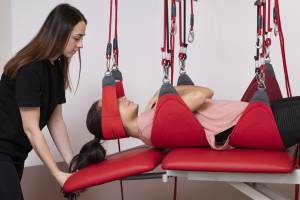When dealing with back pain, spinal issues, or general discomfort, you may come across several treatment options, two of the most popular being traction therapy and chiropractic adjustments. Both methods are designed to improve spinal health and alleviate pain, but they achieve these goals in different ways. If you’re trying to decide which is the best treatment for you, it’s important to understand how each works, their benefits, and which conditions they are most effective at treating.
In this blog post, we’ll break down the key differences between traction therapy and chiropractic adjustments, helping you make an informed decision about which method might be right for your needs.
What is Traction Therapy?

Traction therapy is a form of spinal decompression that aims to relieve pressure on the spine and joints. It involves the use of a traction device that gently stretches and elongates the spine, creating space between the vertebrae and reducing pressure on compressed discs, nerves, and joints.
There are two main types of traction therapy:
- Mechanical Traction: This is the most common form of traction therapy, where a machine or mechanical device applies force to the spine, pulling it in a controlled manner.
- Manual Traction: In this method, a therapist physically manipulates the patient’s body to achieve spinal decompression. This is often used in more localized or targeted cases.
How Does Traction Therapy Work?
The goal of traction therapy is to create negative pressure within the spine, which encourages bulging or herniated discs to retract. By relieving this pressure, traction can reduce irritation on nerves and improve blood flow to the spine, promoting healing.
Traction therapy is often used to treat conditions like:
- Herniated or bulging discs
- Sciatica
- Degenerative disc disease
- Pinched nerves
- Spinal stenosis
- General chronic back pain
Traction therapy is non-invasive, relatively gentle, and requires little effort from the patient beyond lying in the correct position on the traction machine. It’s typically recommended for patients who want to avoid surgery or more aggressive treatments for their spinal issues.
What Are Chiropractic Adjustments?

Chiropractic adjustments, also known as spinal manipulations, involve hands-on treatment by a licensed chiropractor. The chiropractor uses their hands or a small instrument to apply a controlled, sudden force to a specific area of the spine. This adjustment is designed to improve spinal alignment, mobility, and nerve function.
The primary philosophy behind chiropractic care is that proper spinal alignment allows the body to heal itself without the need for medication or surgery. When the spine is misaligned, it can cause problems such as:
- Chronic back or neck pain
- Muscle tension
- Headaches
- Limited mobility
- Nerve pain
Chiropractors most commonly treat musculoskeletal issues like back pain, neck pain, and headaches, but they can also improve overall body function by enhancing nervous system communication.
How Do Chiropractic Adjustments Work?
Chiropractic adjustments are based on the belief that misalignments (called “subluxations”) in the spine can interfere with nerve function, leading to various health problems. During an adjustment, the chiropractor applies quick, precise pressure to the misaligned vertebrae, helping to bring them back into proper alignment.
In addition to spinal adjustments, chiropractors may also use other treatments such as:
- Massage therapy
- Electrical stimulation
- Heat or ice therapy
- Stretching and strengthening exercises
The goal is not just to alleviate pain but to promote long-term spinal health and prevent future problems.
Key Differences Between Traction Therapy and Chiropractic Adjustments
Although both traction therapy and chiropractic adjustments aim to improve spinal health, they differ in several important ways:
- Approach
- Traction Therapy: Involves a passive, mechanical or manual stretching of the spine to relieve pressure. It doesn’t involve sudden movements or manual manipulation of the spine.
- Chiropractic Adjustments: Are active and hands-on, requiring precise, controlled force to manipulate specific joints or vertebrae.
- Target Areas
- Traction Therapy: Focuses on creating space between vertebrae, particularly for those dealing with compressed discs or pinched nerves.
- Chiropractic Adjustments: Target misaligned joints and subluxations, aiming to restore proper alignment and mobility.
- Conditions Treated
- Traction Therapy: Is most effective for conditions involving compressed nerves, herniated discs, and chronic lower back pain. It’s particularly helpful for patients looking for non-invasive decompression treatments.
- Chiropractic Adjustments: Are typically used for treating general back and neck pain, headaches, and musculoskeletal issues caused by poor posture, injury, or subluxations.
- Duration of Treatment
- Traction Therapy: May require multiple sessions over weeks or months, especially for long-term relief of conditions like herniated discs. Sessions are typically short but may need to be repeated for lasting effects.
- Chiropractic Adjustments: Can offer relief in a single session, but many patients opt for ongoing care to maintain spinal health and prevent future issues.
- Patient Involvement
- Traction Therapy: Is a passive treatment; the patient simply lies down and lets the machine or therapist do the work.
- Chiropractic Adjustments: Require the patient to be more engaged, with active participation in exercises and stretches outside of sessions to maximize the benefits of the treatment.
Which One is Right for You?
Choosing between traction therapy and chiropractic adjustments depends largely on your specific condition, your treatment goals, and your personal preferences.
- Choose Traction Therapy if you suffer from conditions like herniated discs, spinal stenosis, or chronic back pain due to compressed nerves. If you prefer a gentle, passive form of therapy that doesn’t involve manual manipulation, traction might be your best option.
- Choose Chiropractic Adjustments if you’re dealing with musculoskeletal pain, headaches, or neck pain due to misaligned vertebrae. Chiropractic care is also a good option if you want a hands-on approach to treating your pain and improving your overall spinal alignment.
Can You Combine Both?
In many cases, patients benefit from a combination of both treatments. For example, traction therapy can help decompress the spine, while chiropractic adjustments can correct misalignments that are causing nerve interference. Many chiropractors offer traction therapy as part of a broader treatment plan, combining it with adjustments to provide comprehensive care.
Conclusion
Both traction therapy and chiropractic adjustments offer effective solutions for spinal health and pain relief, but they cater to different needs. If you’re unsure which treatment is right for you, consulting with a healthcare professional or chiropractor can help you determine the best course of action based on your symptoms and lifestyle. Whether you opt for one method or a combination of both, prioritizing your spinal health is a step toward a pain-free, healthier life.

